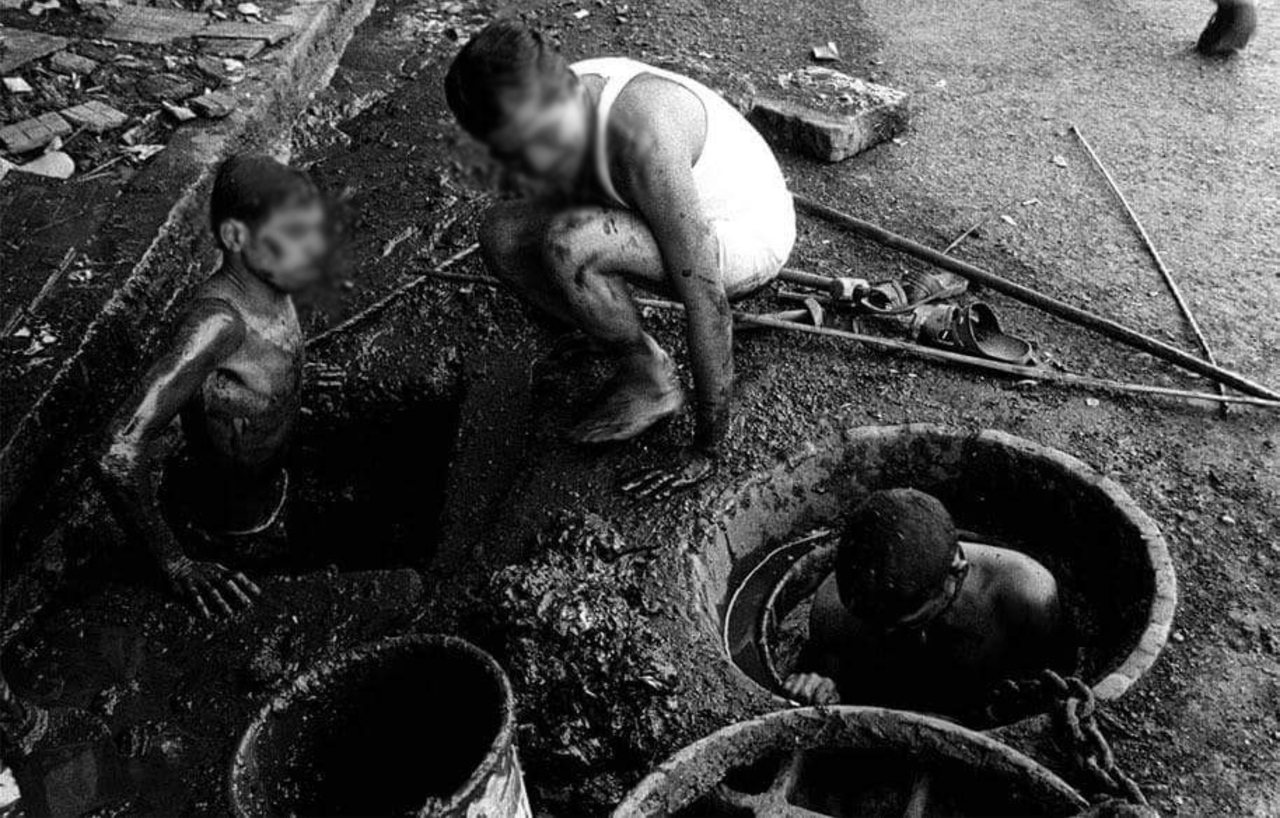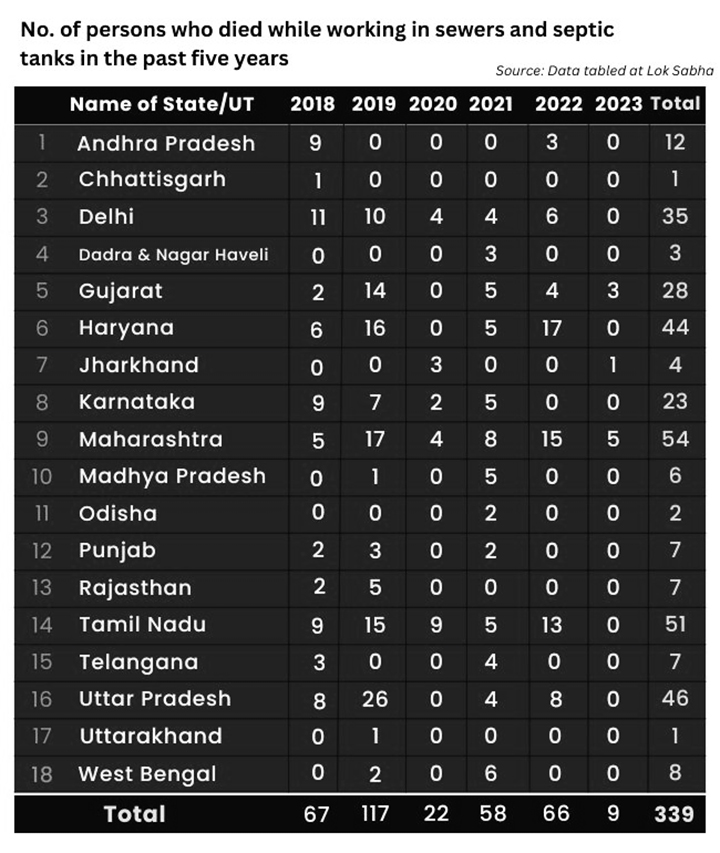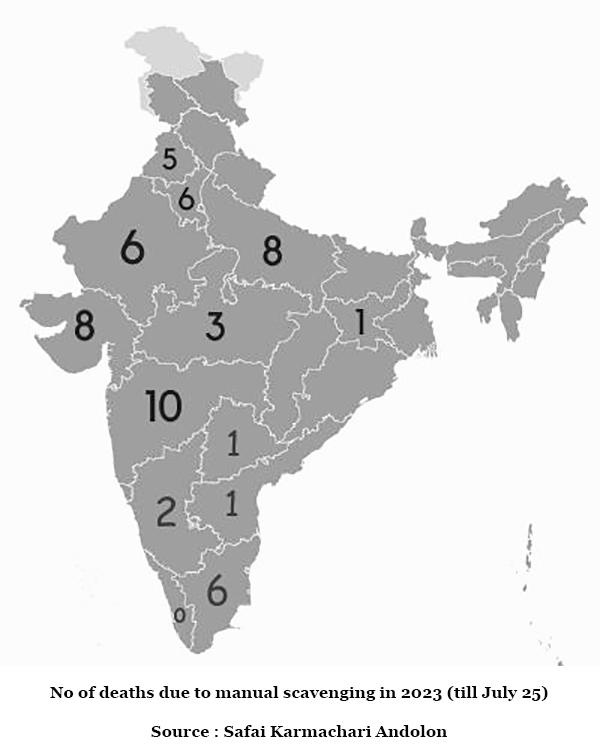Safai Karmachari Andolan (SKA) has objected to the data placed in Parliament by the Union government regarding the number of persons who died while cleaning sewers and septic tanks. SKA said that the figures of death reported by the government are grossly incorrect. A report by Groundxero.
On 25 July, 2023, responding to a question in the Lok Sabha, Union Minister of State for Social Justice and Empowerment, Ramdas Athawale, said that there have been no death due to manual scavenging in India, and that 339 people have died while cleaning sewers and septic tanks in the last five years. According to the government data, nine deaths were recorded in 2023, 66 in 2022, 58 in 2021, 22 in 2020, 117 in 2019, and 67 deaths in 2018 in states/UTs across the country due to hazardous cleaning of sewers and septic tanks and non observance of safety precautions.
Minister Ramdas Athawale also responded to questions raised by MPs P Ravindhranath and Feroze Varun Gandhi, who sought details of manual scavengers in India and if any case has been registered against persons employing manual scavengers. The minister replied that there was “no report of people currently engaged in manual scavenging in the country,” and that no report has been received on any such cases registered.
Safai Karmachari Andolan (SKA), a movement for eradication of manual scavenging, has contested the government’s figures stating that only in this year, from January to till now, 58 persons have lost their lives while cleaning sewers and septic tanks in India. According to the data provided by SKA, the highest number of manual scavenging deaths this year has been recorded in Maharashtra (10). In the south, Tamil Nadu recorded six deaths, Karnataka two, and Andhra Pradesh and Telangana one each. SKA has placed the deaths of these persons in the public domain. On 30 April 2023, The Hindu reported that from March 22 to April 26, 2023, as many as eight people have died while cleaning sewers in various parts of Gujarat. In May this year, The News Minute reported that at least five persons employed in manual scavenging died within a span of 18 days in Tamil Nadu. TNM had also reported the incidents of two youngsters dying while cleaning the sewage treatment plant at an apartment complex in south Bengaluru. All the incidents occurred when the workers without protective gears entered the sewer lines to clean them manually.
The organisation said that the union minister also under-reported the data on the total deaths of manual scavengers in the last five years. The death toll is far above the figure of 339 reported by the minister. SKA also held that the country cannot be declared free of manual scavenging when so many people are getting killed while cleaning sewer and septic tanks. On March 14, 2023, the Social Justice Ministry had informed the Lok Sabha that a total of 1,035 people have died while undertaking hazardous cleaning of sewers and septic tanks across India since 1993, when manual scavenging was outlawed. According to SKA, at least one person dies every day, while cleaning sewers and septic tanks in the country. SKA has documented 1,870 deaths while cleaning sewers in the past 10-15 years. Many of these cases go unreported.
While manual scavenging was outlawed in 1993, the manual cleaning of sewers and septic tanks was decided to be ‘perilous’ only as recently as 2013, in the amended Prohibition of Employment as Manual Scavengers and their Rehabilitation (PEMSR) Act. According to the Section 2(g) of the PEMSR Act, a “manual scavenger” is defined as a person who manually cleans, carries, disposes of, or handles human excreta in any manner in an insanitary latrine or in an open drain or a pit into which the human excreta from the insanitary latrines is disposed of, or on a railway track or other such spaces or premises. This does not include a sewer or a septic tank. The PEMSR Act separately defines “hazardous cleaning” of a sewer or septic tank as “manual cleaning” by a person without the employer providing them with protective gear, other cleaning devices, and without following safety precautions. The Act prohibits employment of manual scavengers and the manual cleaning of sewers and septic tanks without protective equipment.
It is to be noted that though the act of cleaning sewers and septic tanks technically falls under the category of manual scavenging, the government actually distinguishes between deaths due to manual scavenging (cleaning of human excreta by hand) and the ones that occur while cleaning sewers and septic tanks. Taking advantage of the narrow definition of manual scavenging in the Act, the government declares the country free from manual scavenging and reports zero death on this account. SKA said that the government figures on death are not based on facts and it only reflects its apathy towards such deaths of the most vulnerable citizens of this country. It alleged that the government is “putting more efforts on fudging the facts” instead of trying to stop such killings and making this country free from manual scavenging, which is “highly deplorable”.
The PEMSR Act, 2013, also recommends rehabilitation of manual scavengers by providing them with alternative employment and it was for this very reason that the National Safai Karamcharis Finance and Development Corporation (NSKFDC) was established to identify manual scavengers as the government announced compensation and rehabilitation for such workers. Last year the government informed the Lok Sabha that up to November 2021, two surveys conducted in 2013 and 2018 had identified 58,098 manual scavengers who are eligible for rehabilitation. SKM claims that this is severely understated as the 2018 survey was conducted in only 170 identified districts in 18 states, leaving out data from 11 states. SKA is demanding a fresh and transparent survey of manual scavengers to eliminate this atrocity.
A mobile app was launched in December 2020 to identify existing insanitary latrines and manual scavengers engaged therein has had 6,000 cases uploaded, but the Ministry of Social Justice and Empowerment told the Rajya Sabha that it could not confirm the existence of any insanitary latrines, concluding that the practice of manual scavenging does not exist anymore. However, this does not correlate with the findings of Census 2011 that 26 lakh insanitary latrines existed.
In April 2023, the Supreme Court while considering a plea by Safai Karmachari Andolan seeking steps to curb hiring manual scavengers in the country had issued a slew of guidelines for the rehabilitation of manual scavengers, including cash assistance, scholarship for their children, allotment of residential plots, training in livelihood skill and monthly stipends, concessional loans etc. The court directed the Railways to end manual scavenging on tracks. But, even after 15 years of the practice being outlawed, the government scheme to rehabilitate manual scavengers has made little progress. The government’s obstinate denial regarding the existence of manual scavenging is proving to be detrimental in making any real progress.
The Supreme Court has passed an order that it is a crime to force a human being to enter a sewer line, unless it is an emergency, but not without the required safety gears. The reason for criminalising humans entering into sewer lines is the really high probability of death due to the inhalation of poisonous gases. The Supreme Court in its order in 2014 has directed the government to give a compensation of Rs 10 lakhs for such deaths. According to SKA, 1315 deaths were recorded after the court’s order in 2014, but only the families of 266 persons who died while cleaning sewers and septic tanks have received this compensation. This means that despite the court’s order, 80 percent of the victim families have not been compensated.
The only time the stories of manual scavengers make it to the headlines of national newspapers is when they die. They are sent into sewers with complete knowledge and awareness of the dire consequences. Since 11 May 2022, SKA has been running a nationwide campaign #StopKillingUs against deaths in sewers and septic tanks. The campaign has completed 442 days of daily protests across the country. But ironically, instead of trying to stop such killings and making this country free from manual scavenging, the union government is putting more efforts on fudging the facts. It is hiding behind technical definitions in the Law to deny the existence of manual scavengers in the country.
In his book, Karmayog (2007), Narendra Modi (then CM of Gujarat), had justified manual scavenging by calling it a ‘spiritual experience’ for the Valmiki community. He should be told that there is nothing ‘spiritual’ in cleaning other people’s excreta and people dying of asphyxiation or inhaling toxic gases while cleaning sewers manually don’t attain ‘moksha’ (nirvana). This work has been forced upon the Valmiki people who fall lowest in the caste hierarchy; they do it because there is no option, no alternative employment for those born into castes identified with scavenging. It is this mindset towards the Valmiki community that is responsible for the government’s apathy in the implementation of the law in its true spirit, and the deadly dehumanising practice still continues.



